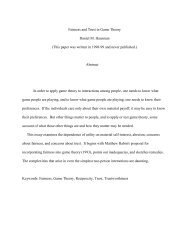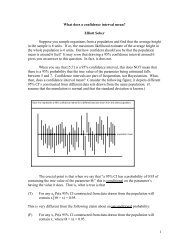Counterexamples to a Likelihood Theory of Evidence
Counterexamples to a Likelihood Theory of Evidence
Counterexamples to a Likelihood Theory of Evidence
Create successful ePaper yourself
Turn your PDF publications into a flip-book with our unique Google optimized e-Paper software.
unders<strong>to</strong>od here, are founded on the <strong>Likelihood</strong> Principle, which may be viewed as thethesis that LTE applies <strong>to</strong> the problem <strong>of</strong> comparing simple hypotheses under theassumption that a background model is true. If what can count as a “background model”is left vague, then the counterexamples <strong>to</strong> LTE are also counterexamples <strong>to</strong> the<strong>Likelihood</strong> Principle.The <strong>Likelihood</strong> Principle has been vigorously upheld (e.g,. Birnbaum 1962,Royall 1991) in reference <strong>to</strong> its most important consequence, called Actualism by Sober(1993)—the reasonable doctrine that the evidential support <strong>of</strong> hypotheses and modelsshould be judged only with respect <strong>to</strong> data that is actually observed. As Royall (1991)emphasizes in terms <strong>of</strong> dramatic examples, classical statistical practice has sometimesviolated Actualism, and sometimes in the face <strong>of</strong> very serious ethical issues. But thelikelihood principle has other consequences besides Actualism, and these might be false.Or, put another way, a theory <strong>of</strong> evidence may deny the <strong>Likelihood</strong> Principle, withoutdenying Actualism. Actualism is strictly adhered <strong>to</strong> in all the examples discussed in thispaper.Section 2 describes what a fit function is, and introduces the idea <strong>of</strong> a fit-functionprinciple. <strong>Likelihood</strong> is described as a measure <strong>of</strong> fit in Section 3, and relationshipbetween the <strong>Likelihood</strong> Principle and LTE is discussed there. The two sections after thatpresent counterexamples <strong>to</strong> LTE, first in terms <strong>of</strong> an example with binary (yes-no)variables, and then in terms <strong>of</strong> continuous variables (a simple curve fitting problem).Fit FunctionsConsider a simple beam balance device (Fig. 1) on which an object a <strong>of</strong> unknownmass, θ, is hung at a unit distance from the fulcrum. Then the position <strong>of</strong> the unit mass onthe right is adjusted until the beam balances. The experiment can be repeated by taking a<strong>of</strong>f the beam and beginning again. Each repetition is called a trial <strong>of</strong> the experiment.One can even change the “unit distance” between trials, provided that x is alwaysrecorded as a proportion <strong>of</strong> that distance. In order <strong>to</strong> experimentally measure the values<strong>of</strong> postulated quantities, like θ, they must be related <strong>to</strong> observed quantities, in this case,the distance, x, at which the unit mass is hung <strong>to</strong> balance the beam.In accordance with standard statistical notation, let X denote the distance variablewhile x refers <strong>to</strong> its observed value. The outcome <strong>of</strong> the first trial might be X = 18. Theoutcome <strong>of</strong> the next trial might be X = 19. It is implausible that the outcomes <strong>of</strong> acontinuous quantity turn out <strong>to</strong> have integer values (or it be could that the device has akind <strong>of</strong> ratchet system that disallows in-between values). X is variable because its valuecan vary from one trial <strong>to</strong> the next. θ is not variable in this sense because its value doesnot change between trials, eventhough its estimated value maychange as the data accumulate.unit distance xTo mark this distinction, θ isreferred <strong>to</strong> as an adjustableparameter.aunit massThe standardNew<strong>to</strong>nian equation relating θand X turns out <strong>to</strong> be veryFigure 1: A simple beam balance.4




